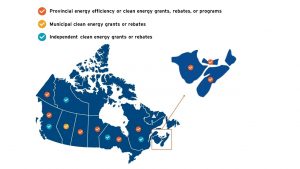After a summer of record heat, floods, and surging power consumption, it’s never been more important to take advantage of proven demand-side management (DSM) strategies that can help manage Ontario’s electricity grid.
There’s nothing new or revolutionary about DSM. We’ve been using it since the 1980s to defer or eliminate the need for grid expansions, reduce peak demand, and make it easier to add more intermittent renewable energy to the system. All of these benefits have two common denominators: they increase grid reliability and efficiency, and they put a brake on rising electricity costs.
What is new is that climate change is steadily driving up summer electricity demand in a system that peaked at 23,852 megawatts (MW) between 4 and 5 PM on June 19, 2024, requiring the province’s Independent Electricity System Operator (IESO) to tap into expensive, high-emitting gas peaker plants for almost a quarter of provincial bulk generation.
With the IESO projecting a 60% increase in electricity demand over the next 25 years, those costs and climate impacts will rise, as well—unless we tap into the opportunity that is already at our fingertips.
The good news? A projection is only as good as the assumptions behind it. With the right public and private investments, DSM is one of the best tools in the toolbox to minimize the need for gas plants and grid expansion, keep electricity costs down, and build on Ontario’s past record as a leading low-carbon power producer.
That status, in turn, will be a cornerstone of our future prosperity, with international investors looking for low-emitting destinations for new research labs, manufacturing plants, data centres, and more.
DSM has two main components: reducing energy demand, and demand response (DR) programs that shift consumption from peak periods when demand is highest.
Beyond the day-to-day energy conservation measures we’ve been hearing about for ages, like turning off lights and air-drying clothes, the big, longer-lasting energy efficiency gains come from measures like installing LED light bulbs, upgrading building envelopes, and installing energy-efficient equipment.
Demand response is already an unsung hero in Ontario. The IESO compensates big, industrial consumers for advancing or postponing demand when they can. And earlier this year, the system operator’s Peak Perks program mobilized more than 100,000 households with smart thermostats to take part in brief, time-limited temperature adjustments of up to 2°C during summer electricity peak events.
The program shifted a maximum of 133 MW the first time it was used, the equivalent of taking a city the size of Barrie, Ontario, off the grid — essentially for the cost of a gift card — as an alternative to building billion-dollar gas plants that add to a cascading global climate emergency. In 2022, an analysis for the IESO by Dunsky Energy + Climate Advisors that DR alone had the economic potential to reduce Ontario’s summer peak load by up to 3.5 GW, in addition to contributions made by new distributed solar and storage.
Private investors should take note.
Last year, the Canadian government estimated the need to attract $140 billion in private investment annually to reach net-zero. To address the staggering opportunity for the investor market, investment tax credits are available for businesses who have invested in clean tech. It’s a leg up for investors looking for low-carbon companies in their portfolio.
Within TAF’s own investment screening process, we’ve seen an influx in clean technology startups that integrate smart grid technology or demand-response solutions. For example, we recently partnered with Optiwatt to launch a pilot project in the GTHA for smart EV charging to test and demonstrate DR optimization strategies. We recommend learning more about the many DSM investing opportunities. And, reach out to our team if you’re seeking investment in this area.
Such investment should be able to leverage public investment and policy certainty. It would be wise for Ontario (and all the provinces) to commit to a least-cost energy strategy where we save as much electricity and shift as much load as we can before deciding how much more generating capacity—even renewable capacity—we need to build.
Learn More about DSM Initiatives in Canada
This map shows the range of DSM initiatives across Canada, including energy efficiency rebates, low-income community projects, and demand response incentives as of July, 2024.

Key Programs
-
BC demand response trial for business refrigeration systems (May 2024 to April 2025)
-
BC Hydro Peak Saver programs provide financial incentives for reduced energy use (i.e. event with 20% reduction gives $3 reward)
-
SaskPower demand-response program for industrial consumers to reduce 5MW of energy
-
IESO hosts a capacity auction program allowing offers between 1MW to enrolled capacity to purchase excess energy supply
-
Ontario’s Peak Perk programs provides prepaid credit cards for conserving energy in peak demand periods in the summer
-
New Brunswick Peak Rebate program is open to both residential and business consumers and provides $60/kWh saved

